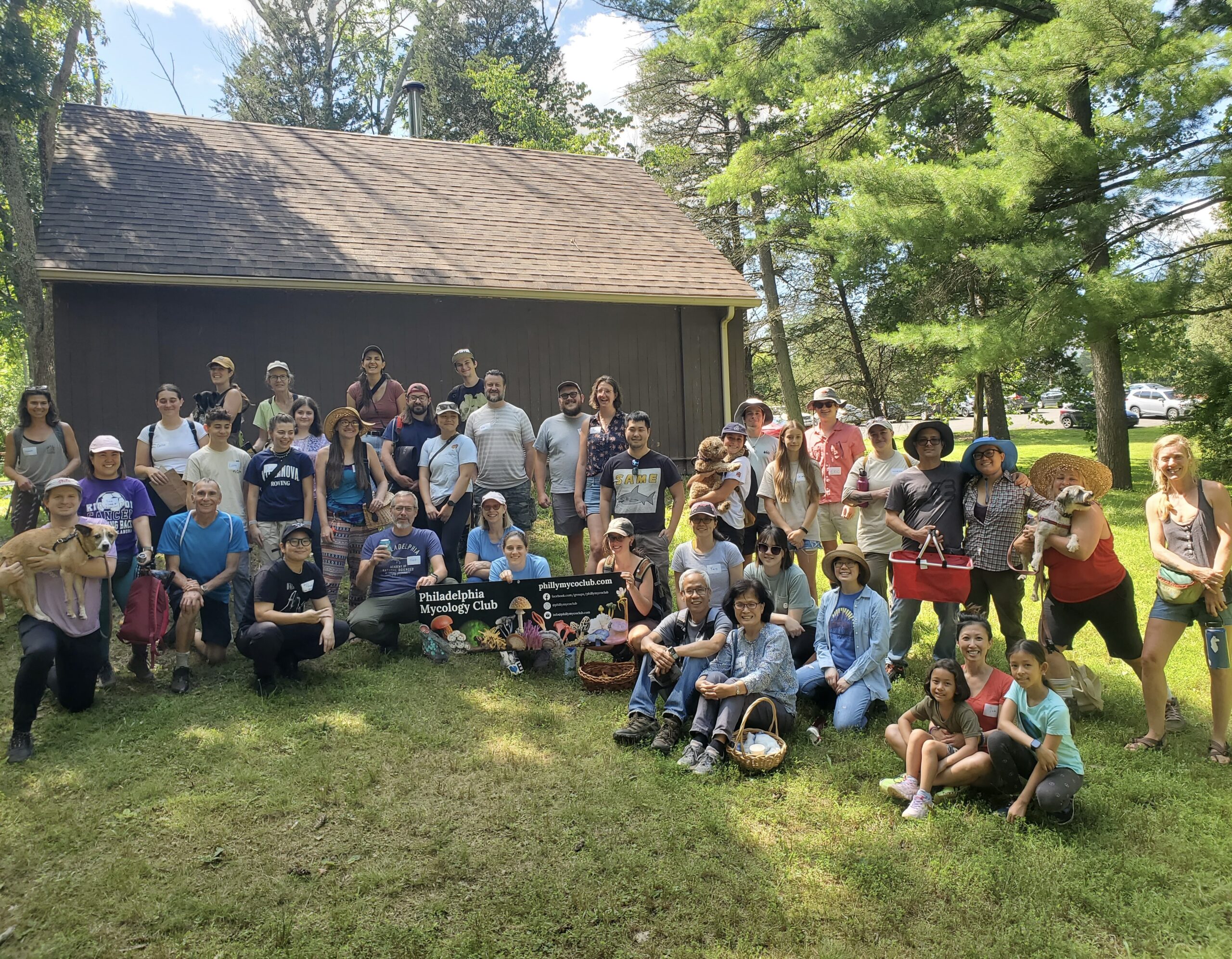Fun with Fungi: An Overview of the Philadelphia Mycology Club
By Sam Herring
Mushrooms are a revered food for some, while others bristle at the thought of eating them, no matter how they’re prepared. The Philadelphia Mycology Club (PMC) plays host to many mushroom enthusiasts with a desire to learn more about foraging, identifying, and preserving fungi and fungal diversity in our local ecosystem. According to their website, “the Philadelphia Mycology Club was founded in 2018 by Beth Teigen and has since grown to include a diverse group of novice and experienced mycologists. They work with other environmental groups in and around Philadelphia to provide free and accessible mushroom guidance in an urban setting and to work towards our common goals of environmental justice.” After attending multiple PMC mushroom forays, trash cleanups, and interviewing Beth, I discovered that the club is exactly that and so much more. Having found myself enamored with the subject of mycology and encouraged as a novice by the engaging club members, I was inspired to learn more about the club’s formation, growth, and future goals.
Beth’s fascination with mushrooms started organically while walking dogs in her urban community of Philadelphia. She unexpectedly found an abundance of mushrooms popping up after rainstorms. She began taking pictures of them and sharing them with her friends, but to her chagrin, they did not share in her heartened enthusiasm. Sparked by a desire to learn and understand these organisms she found so fascinating, Beth decided to start a small group on Facebook to connect with others who shared her affinity for terrestrial toadstools. She organized small walks with this group at first, centered around an amateur curiosity, fueled by a jovial approach to foraging and identifying. These early meetings gained traction over the years. More fungal fanatics joined the fold, increasing their knowledge base and helping to educate Beth and other amateur mycologists. Since then, the group has continued to grow and formed a non-profit organization with 10 volunteers hosting monthly guided walks, forays, trash cleanups, and potlucks in the greater Philadelphia area.
This spirit of inclusivity, connection, and shared values is what drives the club forward, welcoming anyone who wants to learn more about mushrooms. One of Beth’s goals is to “form a community for people who haven’t found it elsewhere.” An informative, widespread approach to championing environmental stewardship underpins how the club uses fungi to generate interest in the pursuit of environmental justice. Beth explains a goal “to aid in a cultural shift to keep mycology in mind in the same ways that we keep animals and plants in mind when we are doing restoration or conservation.”
Keeping mycology in mind is easy for food lovers who revel in the abundance of quality mushrooms such as maitakes, oysters, and chantarelles emerging from the soil of our local forests. Gourmet gems like these can rarely be found at stores, except in packages with sticker prices that can top $15-20 per pound, a steep barrier for consumers, especially those who may be ambivalent about sampling unique fungi in the first place. Foraged mushrooms present an opportunity for people to try these top-tier ingredients for free, albeit with a little work, and their terrestrial homes may require a shorter drive than the supermarket. Beth explains the environmental impact of this natural abundance; “I think aiding in that shift to keep mycology in mind will help to aid in the shift of protecting our green spaces because I don’t think that we can protect our green spaces if we don’t have people that care about what can be found in our green spaces”.
It’s clear that PMC’s educational focus aids in preserving our natural spaces and biodiversity, but Beth also understands its power in combating threads of mycophobia, a fear of fungi and molds, that is prevalent in our society. This misguided fear influences many people to incorrectly assume that any mushroom and its environment are toxic. Teigen assures everyone upon introduction at club events that ALL mushrooms are safe to get close to and touch. This comes with the caveat that some mushrooms are poisonous if eaten and one should carefully identify fungi before eating them. Beth emphasizes, however, that even the most toxic mushrooms present no danger to humans unless they are chewed and swallowed. That said, many local mushrooms are not only safe to eat but also delicious and succulent! In addition to the free cost of these wild food sources, fungi are rich sources of protein. Additionally, the Harvard School of Public Health, notes other benefits of mushrooms include substances like polyphenols and polysaccharides: which provide antioxidant, anti-inflammation, and cancer-fighting effects. Also, their nutrient-dense profile and high amino acid concentrations give them a rich “umami” flavor, the savory complexity that gives other foods like parmesan cheese and beef their satisfyingly delicious flavors. Gourmet mushrooms, like chicken of the woods and chantarelles, are delightful, and relatively inaccessible for most people, often found hiding on the tasting menus of cloth napkin folding, reservation-only eateries. However, with PMC’s education about these wonderful species and their local presence, mushrooms become an available resource for us to find and cook for ourselves! PMC’s effort to inform, shepherd, and grow with others in their exploration of fungi is a remarkable contribution to our community and one that can be appreciated by anyone with a desire to learn.

